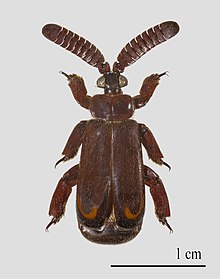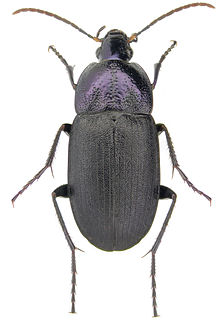| Cerapterus | |
|---|---|
 | |
| Cerapterus pilipennis - Muséum de Toulouse | |
| Scientific classification | |
| Kingdom: | Animalia |
| Phylum: | Arthropoda |
| Class: | Insecta |
| Order: | Coleoptera |
| Suborder: | Adephaga |
| Family: | Carabidae |
| Genus: | Cerapterus Swederus, 1788 |
Cerapterus is a genus of beetles in the family Carabidae, containing the following species: [1]

Beetles are a group of insects that form the order Coleoptera, in the superorder Endopterygota. Their front pair of wings are hardened into wing-cases, elytra, distinguishing them from most other insects. The Coleoptera, with about 400,000 species, is the largest of all orders, constituting almost 40% of described insects and 25% of all known animal life-forms; new species are discovered frequently. The largest of all families, the Curculionidae (weevils) with some 70,000 member species, belongs to this order. Found in almost every habitat except the sea and the polar regions, they interact with their ecosystems in several ways: beetles often feed on plants and fungi, break down animal and plant debris, and eat other invertebrates. Some species are serious agricultural pests, such as the Colorado potato beetle, while others such as Coccinellidae eat aphids, scale insects, thrips, and other plant-sucking insects that damage crops.
- Cerapterus benguelanus H.Kolbe, 1926
- Cerapterus brancae Luna De Carvalho, 1961
- Cerapterus burgeoni Reichensperger, 1937
- Cerapterus calaharicus H.Kolbe, 1926
- Cerapterus concolor Westwood, 1850
- Cerapterus denoiti Wasmann, 1899
- Cerapterus drescheri Reichensperger, 1935
- Cerapterus elgonis Reichensperger, 1938
- Cerapterus herrei Schultze, 1923
- Cerapterus horni Reichensperger, 1925
- Cerapterus horsfieldi Westwood, 1833
- Cerapterus hottentottus H.Kolbe, 1896
- Cerapterus immaculatus Luna De Carvalho, 1975
- Cerapterus kolbei Lorenz, 1998
- Cerapterus laceratus (C.A.Dohrn, 1891)
- Cerapterus lafertei Westwood, 1850
- Cerapterus latipes Swederus, 1788
- Cerapterus leoninus H.Kolbe, 1926
- Cerapterus longihamus Reichensperger, 1933
- Cerapterus myrmidonum H.Kolbe, 1896
- Cerapterus oblitus Reichensperger, 1938
- Cerapterus parallelus Wasmann, 1922
- Cerapterus pilipennis Wasmann, 1922
- Cerapterus pseudoblitus Luna De Carvalho, 1961
- Cerapterus pygmaeus Luna De Carvalho, 1960
- Cerapterus quadrimaculatus Westwood, 1841
- Cerapterus smithii Westwood, 1838
- Cerapterus splendidus Wasmann, 1918
- Cerapterus stalii Westwood, 1874
- Cerapterus stuhlmanni H.Kolbe, 1895
- Cerapterus trinitatis H.Kolbe, 1896






